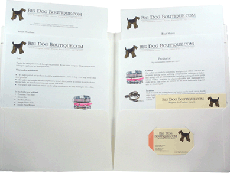
A basic media kit. Photo courtesy of BigDogBoutique.com.
THE AUTHOR |
KAREN HOCHMAN, Editorial Director of THE NIBBLE, sees more than 1,000 media kits a year. She wishes she could share a copy of these best practices to some of their creators.
|
June 2005
Updated February 2009
|
 |
Media Kit Components
Page 2: Media Kit Components
This is Page 2 of a five-page article. Click on the black links below to visit other pages.
Media Kit Components
A media kit is a marketing vehicle, and should reflect your brand throughout.
- Cover. The cover of the folder, CD-ROM or other carrier* should bear your name, logo and tag line. No matter how well-known your company is, the cover should have a positioning statement indicating who the company is and what products/services it provides. While companies in the chips have custom-designed folders, it is a time-honored tradition to use stock color paper folders with pockets. (Many journalists toss the folders anyway, because they take up too much room in the files.) Fashionable these days are the clear poly folders and poly envelopes available everywhere in clear and colors. They save you the need to affix labels because your first page will show through and do the announcing for you.
*Jewelry companies have been known to deliver their media kits in a jewelry box; apparel companies in a duffel bag; food companies in a canister, candy box or fortune cookie container. You can be as imaginative as your budget allows, as long as it’s appropriate for your product.
The folder or other medium should contain the following:
- Corporate Backgrounder. A history and summary of the company (one page or less).
- Management Biographies. Bios of key company managers. It’s nice to include photos with the bios, but not essential. (You don’t need to include glossies these days: Reporters will call for jpgs if they need them.)
- Recent News Releases. Information about your products, company growth, new executives, etc.
- Recent Media Coverage. Copies of favorable articles, reviews and other press coverage the company and its products have received. (Be selective: less is more. As your press clippings grow, weed out the lesser ones; it puts more focus on the better ones. “Lesser” doesn’t necessarily refer to the fame of the media outlet, but how much they have to say about your product.)
- Product Information. Brochures, line sheets, etc.
- Samples. Some products lend themselves to enclosures, e.g. a single shrink-wrapped cookie or a jerky stick. As long as your product will survive in transit, include it. Not only is it informative, it makes your press kit fun. Otherwise, consider a separate sheet or cover letter inviting the recipient to contact you for samples.
- Company Information. Summary of any upcoming events, appearances at trade shows, company and customer newsletters.
- Contact Information. Generally the business card of the key media contact. In a smaller company, this can be the owner; in a midsize company, it can be the head of marketing or sales. Larger companies and some smaller ones have dedicated public relations directors and/or external media representatives (public relations agencies).
To make your printed materials more interesting, look at reasonably-priced quality paper stocks available by the ream. You can use colored paper stock (whatever paper you choose, be sure the print is easily readable). Even if you can’t afford a custom-designed and custom-printed press kit, you can create something just as exciting with imagination and taste. Just as with a wardrobe selection, coordinate your folder and paper to your business card for a pulled-together look.
- TIP: If this isn’t your strong suit, call the art department at your local college and ask a graphic design professor to recommend two of his/her best students to create a press kit look for you. Give each a $50 project fee plus $25 for materials to produce as many ideas as they like—you’ll be amazed what they come up with. Be sure to discuss up-front what the components and total cost of the final kit should be. Afterward, they may be available to help you create and assemble the kits.
Continue To Page 3: Online Media Kits
Go To The Article Index Above
© Copyright 2005-2025
Lifestyle Direct, Inc. All rights reserved. Images are the copyright of their respective owners.

|




